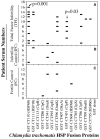Association of tubal factor infertility with elevated antibodies to Chlamydia trachomatis caseinolytic protease P
- PMID: 20643392
- PMCID: PMC3223063
- DOI: 10.1016/j.ajog.2010.06.005
Association of tubal factor infertility with elevated antibodies to Chlamydia trachomatis caseinolytic protease P
Abstract
Objective: The objective of the study was to assess antibodies against Chlamydia trachomatis heat shock proteins (HSP) in patients with tubal factor infertility (TFI), infertility controls (IFC), and fertile controls (FC). HSPs assist organisms in surviving caustic environments such as heat.
Study design: Twenty-one TFI, 15 IFC, and 29 FC patients were enrolled after laparoscopic tubal assessment. The titers of antibodies against C trachomatis organisms and 14 chlamydial HSPs were compared among the 3 groups.
Results: TFI patients developed significantly higher levels of antibodies against C trachomatis and specifically recognizing chlamydial HSP60 and caseinolytic protease (Clp) P, a subunit of the ATP-dependent Clp protease complex involved in the degradation of abnormal proteins.
Conclusion: In addition to confirming high titers of antibodies against C trachomatis organisms and HSP60 in TFI patients, we identified a novel link of TFI with anti-ClpP antibodies. These findings may provide useful information for developing a noninvasive screening test for TFI and constructing subunit anti-C trachomatis vaccines.
Copyright © 2010 Mosby, Inc. All rights reserved.
Figures



References
-
- Centers for Disease Control and Prevention . Sexually transmitted disease surveillance, 2007. U.S. Department of Health and Human Services; Atlanta, GA: Dec, 2008.
-
- Centers for Disease Control and Prevention . Sexually transmitted disease surveillance 2007 supplement, Chlamydia Prevalence Monitoring Project Annual Report 2007. U.S. Department of Health and Human Services, Centers for Disease Control and Prevention; Atlanta, GA: Jan, 2009.
-
- Keilani A, Boulieu D, Raudrant D, Carraz M, Quenin P. [Role of Chlamydia trachomatis in tubal pathology (acute salpingitis and tubal sterility). Microbiological study of 175 samples of peritoneal fluid] J Gynecol Obstet Biol Reprod (Paris) 1989;18:167–72. - PubMed
-
- Arno JN, Yuan Y, Cleary RE, Morrison RP. Serologic responses of infertile women to the 60-kd chlamydial heat shock protein (hsp60) Fertil Steril. 1995;64:730–5. - PubMed
-
- Cates W, Jr, Wasserheit JN. Genital chlamydial infections: epidemiology and reproductive sequelae. Am J Obstet Gynecol. 1991;164:1771–81. - PubMed
Publication types
MeSH terms
Substances
Grants and funding
LinkOut - more resources
Full Text Sources
Other Literature Sources
Medical
Research Materials
Miscellaneous

